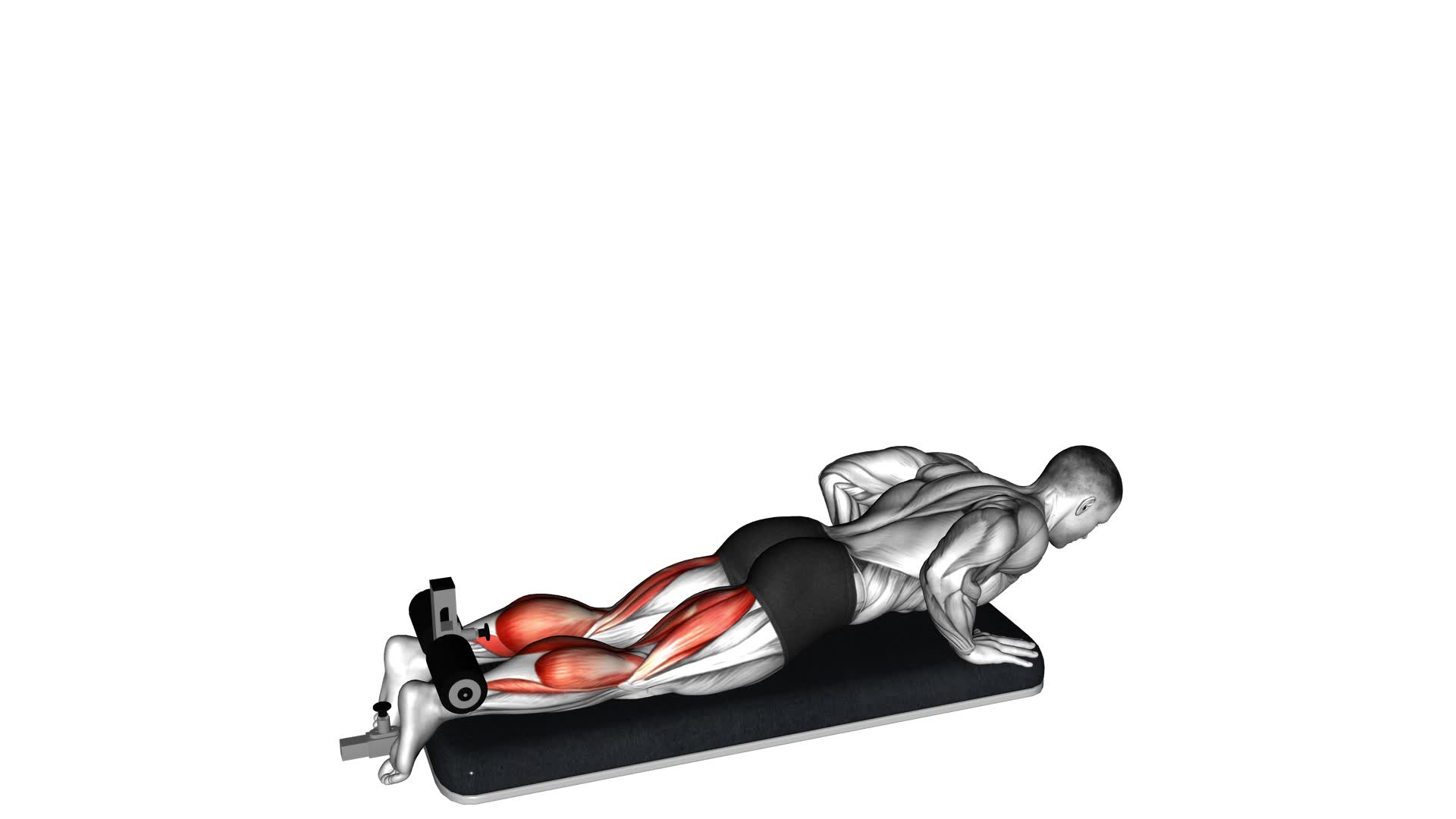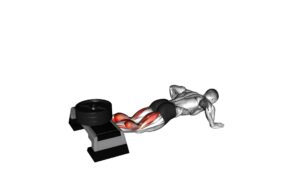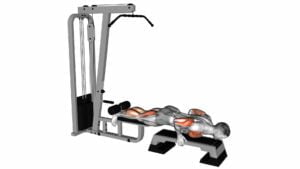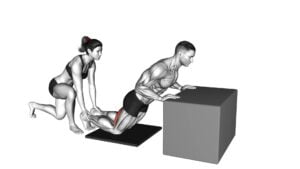Inverse Leg Curl With Bench Pads – Video Exercise Guide & Tips

Looking to tone and strengthen your legs? Then the inverse leg curl with bench pads is the exercise for you. In this video exercise guide, we'll show you the proper form and technique to maximize your results.
Watch This Exercise Video
Whether you're a beginner or an advanced user, there are variations and progressions to suit your fitness level. Avoid common mistakes and stay safe with our helpful tips and precautions.
Let's get started!
Key Takeaways
- The inverse leg curl exercise strengthens and tones the hamstrings, glutes, and calves.
- It reduces the risk of strains and tears in the lower body muscles.
- The exercise improves stability, balance, and lower body function for activities like running and jumping.
- The inverse leg curl can be adapted for different fitness levels and goals.
Benefits of the Inverse Leg Curl
The inverse leg curl provides numerous benefits for your lower body strength and flexibility. This exercise is highly effective in preventing injuries and improving overall lower body function. By targeting the hamstrings, glutes, and calves, the inverse leg curl helps to strengthen these muscles, reducing the risk of strains and tears. It also helps to improve stability and balance, which is crucial for injury prevention in activities such as running and jumping.
When performing the inverse leg curl, it's important to use the recommended weight variations. Beginners should start with lighter weights to focus on proper form and technique. As you progress, gradually increase the weight to challenge your muscles and continue making improvements. However, it's crucial to avoid using excessive weight that could lead to injury. Finding the right balance is key.
Incorporating the inverse leg curl into your lower body workout routine can greatly benefit your overall strength and flexibility. It's a versatile exercise that can be modified to suit different fitness levels and goals. Remember to always warm up before starting any exercise and consult with a fitness professional if you have any concerns or questions.
Equipment and Setup for the Exercise
To properly set up and perform the inverse leg curl with bench pads, you'll need a sturdy bench and adjustable ankle straps. These two pieces of equipment are essential for executing the exercise correctly and safely.
First, find a bench that's stable and can support your body weight. Make sure it's positioned in a clear space with enough room for your legs to move freely.
Next, attach the adjustable ankle straps to the bench. These straps will secure your feet and ankles during the exercise, providing stability and control. Adjust the straps to a comfortable fit, ensuring they're snug but not too tight.
Once the bench and ankle straps are set up, lie face down on the bench with your legs extended and your ankles secured in the straps. Your body should be aligned with the bench, and your hips should be at the edge of the bench.
Before starting the exercise, make any necessary modifications based on your fitness level and comfort. You can adjust the bench height to increase or decrease the difficulty of the exercise. Additionally, you can use a resistance band or ankle weights to add resistance and intensity to the movement.
Proper Form and Technique
To perform the inverse leg curl with proper form and technique, it's important to avoid common mistakes such as using momentum and not fully extending your legs.
By maintaining control and using a slow and controlled movement, you can effectively target your hamstrings and glutes.
Proper form and technique not only help prevent injuries, but also maximize the benefits of the exercise, leading to stronger and more defined leg muscles.
Avoiding Common Mistakes
When performing the inverse leg curl with bench pads, ensure proper form and technique by focusing on your body positioning and using a controlled range of motion.
One common misconception is that you should use momentum to swing your legs up. However, this can lead to injury and ineffective results. Instead, engage your hamstrings and glutes to lift your legs, keeping the movement slow and controlled.
Another mistake to avoid is neglecting proper breathing techniques. Remember to exhale as you lift your legs and inhale as you lower them. This helps stabilize your core and maintain control throughout the exercise.
Benefits of Proper Technique
By focusing on your body positioning and using a controlled range of motion, you can reap the benefits of proper technique in the inverse leg curl with bench pads. Proper form is crucial as it helps to target the muscles effectively and avoid unnecessary strain or injury.
When you maintain the correct form, you engage the hamstring muscles more efficiently, leading to greater strength and muscle development. Additionally, proper technique ensures that you're engaging the correct muscles throughout the exercise, maximizing its effectiveness. It also helps to improve your overall stability and balance.
Variations and Progressions for Advanced Users
For advanced users, incorporating challenging variations and progressions into your inverse leg curl with bench pads routine can significantly enhance your lower body strength and stability.
Here are three advanced modifications and training techniques to take your leg curl exercise to the next level:
- Single-Leg Inverse Leg Curl: This variation focuses on isolating one leg at a time, increasing the demand on your hamstrings and glutes. Start by positioning yourself on the bench pads with one leg extended and the other bent at the knee. Perform the leg curl movement using only the extended leg, maintaining control and stability throughout the exercise. Switch legs and repeat for a balanced workout.
- Weighted Inverse Leg Curl: To further challenge your muscles, add resistance by using ankle weights or holding a dumbbell between your feet. This additional weight increases the intensity of the exercise, forcing your muscles to work harder and adapt to the increased load.
- Swiss Ball Inverse Leg Curl: Incorporating a Swiss ball adds an element of instability, requiring more core engagement and balance. Position the Swiss ball near the bench pads, place your heels on top of the ball, and perform the leg curl movement while keeping your hips lifted. This variation not only targets your hamstrings but also activates your core muscles for improved stability.
Common Mistakes to Avoid
To ensure proper form during the inverse leg curl with bench pads exercise, there are a few key tips to keep in mind.
First, make sure to maintain a controlled and slow movement throughout the exercise to effectively target the hamstrings.
Secondly, avoid arching your back or using momentum to lift the weight, as this can lead to injury.
Lastly, it's important to adjust the weight according to your fitness level and gradually increase it over time to avoid strain or overexertion.
Proper Form Tips
To ensure proper form during the inverse leg curl with bench pads, consistently maintain a straight back throughout the exercise. This is crucial for both injury prevention and maximizing the effectiveness of the exercise.
Here are three important tips to help you maintain proper form:
- Keep your core engaged: By activating your core muscles, you stabilize your spine and prevent excessive movement. This will help maintain a straight back throughout the exercise.
- Control the movement: Avoid using momentum to swing your legs up. Instead, focus on using your hamstring muscles to control the movement and lift your legs in a slow and controlled manner.
- Adjust the bench pads: Make sure the bench pads are properly positioned to support your lower legs. This will provide stability and prevent any discomfort or strain on your knees or ankles.
Injury Prevention Techniques
Avoid making the mistake of neglecting injury prevention techniques during the inverse leg curl with bench pads.
Injury prevention exercises and stretching techniques are crucial to protect yourself from potential harm. Before starting the exercise, it's important to warm up your muscles with dynamic stretches such as leg swings or high knees. This will increase blood flow and flexibility, reducing the risk of injury.
During the exercise, maintain proper form and avoid jerking or using momentum. Keep a controlled and slow pace to engage the targeted muscles effectively. Additionally, listen to your body and stop if you feel any pain or discomfort.
Remember to cool down after the exercise with static stretches to improve flexibility and prevent muscle soreness. By incorporating injury prevention techniques, you can enjoy a safe and effective inverse leg curl workout.
Recommended Weight Variations
Continue protecting yourself from potential harm and maximizing the effectiveness of your inverse leg curl with bench pads by using recommended weight variations and avoiding common mistakes.
Here are some weight recommendations and modification options to consider:
- Start with a weight that allows you to perform the exercise with proper form and control. It should challenge your muscles without causing excessive strain or discomfort.
- As you progress, gradually increase the weight to continue challenging your muscles and promoting strength gains. However, avoid using weights that are too heavy, as this can lead to poor form and potential injuries.
- If you find the exercise too challenging or are recovering from an injury, you can modify it by using resistance bands or decreasing the weight load.
By following these weight recommendations and modification options, you can tailor the exercise to your fitness level and goals.
Now, let's move on to the next section, where we'll discuss safety tips and precautions to keep in mind.
Safety Tips and Precautions
Make sure to place the bench pads at the appropriate height for your comfort and safety. Proper positioning of the bench pads is crucial to ensure injury prevention and maintain proper form during the inverse leg curl exercise. When setting up the bench pads, make sure they're at a height that allows your legs to be fully extended but not locked out. This will provide adequate support for your lower body while allowing for a full range of motion.
Additionally, it's important to maintain proper form throughout the exercise. Start by lying face down on the bench with your legs extended behind you and your ankles secured under the foot pads. As you initiate the movement, contract your hamstrings to flex your knees and bring your heels toward your glutes. Avoid using momentum or jerking motions, as this can increase the risk of injury. Instead, focus on controlled and deliberate movements, squeezing your hamstrings at the top of the movement.
To further prevent injury, always warm up before performing the inverse leg curl exercise. This can be done through light cardio exercises such as walking or cycling to increase blood flow to the muscles and prepare them for the workout. Additionally, listen to your body and stop the exercise if you experience any pain or discomfort. Remember, safety should always be your priority when performing any exercise.
Frequently Asked Questions
How Many Sets and Reps Should I Do for the Inverse Leg Curl Exercise?
To determine the number of sets and reps for the inverse leg curl exercise, you need to consider your fitness goals and current fitness level.
Progression options include gradually increasing the number of sets or reps over time.
Common mistakes to avoid include using momentum to lift your legs and not maintaining proper form.
Prioritize quality over quantity, and consult a fitness professional for personalized guidance.
Can I Perform the Inverse Leg Curl Exercise Without Using Bench Pads?
Yes, you can definitely perform the inverse leg curl exercise without using bench pads. There are alternative equipment options available, such as using a stability ball or a yoga mat.
If you don't have any equipment, you can modify the exercise by lying on the floor and placing your feet on a towel or a blanket. Just make sure to engage your core and focus on keeping your form correct throughout the movement.
Is the Inverse Leg Curl Exercise Suitable for Beginners?
Proper form is crucial when doing the inverse leg curl exercise. It's important for beginners to focus on technique to avoid injury.
Make sure your back is flat against the bench pads and your core is engaged. Avoid arching your back or using momentum to lift your legs.
Start with a lighter weight and gradually increase as you build strength. Take your time and concentrate on the movement to get the most out of this exercise.
Should I Feel Any Specific Muscle Group Working During the Inverse Leg Curl Exercise?
When performing the inverse leg curl exercise, it's important to focus on proper form and technique. You should feel the muscles in the back of your thighs, known as the hamstrings, working during this exercise.
It's crucial to avoid common mistakes such as using momentum or lifting your hips off the bench. By maintaining proper form and technique, you can effectively target and strengthen your hamstrings with the inverse leg curl exercise.
Can I Substitute the Inverse Leg Curl Exercise With Other Hamstring Exercises?
Yes, you can substitute the inverse leg curl exercise with other hamstring exercises. There are several alternative hamstring exercises you can try, such as deadlifts, glute bridges, and Romanian deadlifts.
However, it's important to note that the inverse leg curl offers unique benefits compared to other hamstring exercises. It specifically targets the muscles in the back of your thighs and helps improve hamstring strength and stability.
Conclusion
In conclusion, the inverse leg curl with bench pads is a highly effective exercise for targeting the hamstrings and glutes.
By following the proper form and technique, utilizing variations and progressions, and avoiding common mistakes, you can maximize the benefits of this exercise.
Remember to prioritize safety by using appropriate equipment and taking necessary precautions.
Incorporate the inverse leg curl into your fitness routine to strengthen and tone your lower body.

Author
Years ago, the spark of my life’s passion ignited in my mind the moment I stepped into the local gym for the first time. The inaugural bead of perspiration, the initial endeavor, the very first surge of endorphins, and a sense of pride that washed over me post-workout marked the beginning of my deep-seated interest in strength sports, fitness, and sports nutrition. This very curiosity blossomed rapidly into a profound fascination, propelling me to earn a Master’s degree in Physical Education from the Academy of Physical Education in Krakow, followed by a Sports Manager diploma from the Jagiellonian University. My journey of growth led me to gain more specialized qualifications, such as being a certified personal trainer with a focus on sports dietetics, a lifeguard, and an instructor for wellness and corrective gymnastics. Theoretical knowledge paired seamlessly with practical experience, reinforcing my belief that the transformation of individuals under my guidance was also a reflection of my personal growth. This belief holds true even today. Each day, I strive to push the boundaries and explore new realms. These realms gently elevate me to greater heights. The unique combination of passion for my field and the continuous quest for growth fuels my drive to break new ground.







